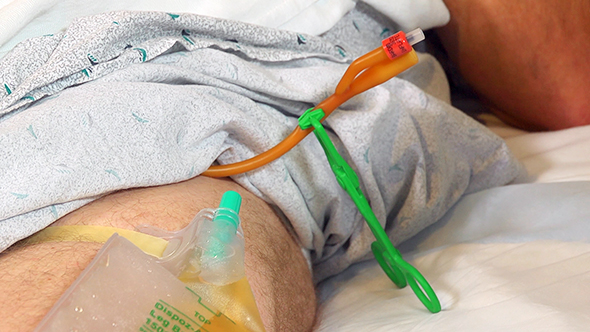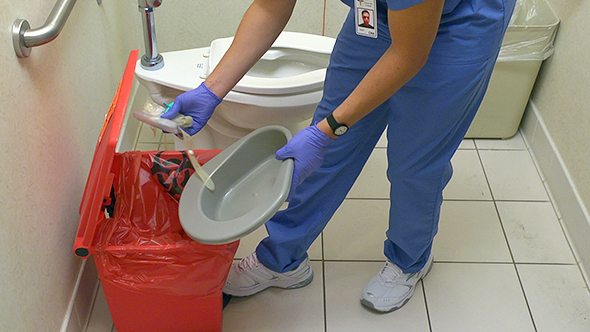Elimination Assistance
Select a Skill:
- » Helping the Person to the Commode
- » Applying Incontinence Products
- » Giving the Urinal
- » Giving the Bedpan
- » Applying a Condom Catheter
- » Giving Catheter Care
- » Emptying a Urinary Drainage Bag
- » Changing a Leg Bag to a Drainage Bag
- » Giving an Enema
- » Changing an Ostomy Pouch
Take the Review Test:

Purpose

- A closed drainage system is used for indwelling catheters. Only urine should enter the drainage bag.
- A urinary tract infection (UTI) can occur if microbes enter the drainage system. The microbes travel up the tubing or catheter into the bladder and kidneys.
- The two types of drainage bags are leg bags (which hold less than 1,000 mL of urine) and standard drainage bags (which usually hold at least 2,000 mL of urine).
- Some people wear leg bags when up. The leg bag attaches to the thigh or calf.
- Leg bags are changed to drainage bags when the person is in bed. You need to open the closed drainage system. You must prevent microbes from entering the system.
- To prevent UTIs, keep the drainage bag lower than bladder level.
- Tell the nurse at once if the drainage system becomes disconnected.
- Empty drainage bags and measure urine:
- At the end of every shift
- When changing from a leg bag to a standard drainage bag (or vice versa)
- When the bag is becoming full
Equipment
Roll cursor over items to see labels. For the purposes of clearly depicting the equipment, a barrier is not shown in this photo. When providing care, a barrier should always be placed on the surface before placing the equipment.

Bedpan
Sterile cap and plug
Drainage bag and tubing
Bath blanket
Gloves
Antiseptic wipes
Catheter clamp
Waterpoof pad
Paper towels
Delegation
- Follow delegation guidelines. Before changing a leg bag to a drainage bag, obtain this information from the nurse and care plan:
- When to empty the drainage bag
- If the person uses a leg bag
- When to switch a standard drainage bag and leg bag
- If you should clean or discard the drainage bag
- What observations to report and record
- When to report observations
- What patient or resident concerns to report at once
Preparation

- Observe quality-of-life measures.
- Review the information under Delegation and Safety and Comfort.
- Collect the equipment.
- Arrange paper towels and equipment on the over-bed table.
- Identify the person. Check the ID bracelet against the assignment sheet. Call the person by name.
- Provide for privacy.
Safety

- Urine may contain microbes and blood. Follow Standard Precautions and the Bloodborne Pathogen Standard.
- This procedure requires you to open sterile packages. You must keep sterile items free from contamination.
- Leg bags fill faster than standard drainage bags. Check leg bags often. Empty the leg bag if it is becoming half full. Measure, report, and record the amount of urine.
Comfort
- Urine in a drainage bag embarrasses some people. Visitors can see the urine. To promote mental comfort, have visitors sit on the side away from the drainage bag. Sometimes you can empty the bag before visitors arrive. Make sure you measure, report, and record the amount of urine.
- Some agencies have drainage bag holders. The drainage bag is placed inside the holder. Urine cannot be seen.
Procedure Video
Audio Description: OFFFollow-up Care

- Provide for comfort.
- Place the call light within reach.
- Lower the bed to its lowest position. Raise or lower bed rails. Follow the care plan.
- Unscreen the person.
- Put on clean gloves. Discard disposable items.
- Empty the drainage bag, as in the Video Skill “Emptying a Urinary Drainage Bag.”
- Discard the drainage tubing and bag—or clean the bag—following agency policy.
- Clean and disinfect the bedpan. Place it in a clean cover.
- Return the bedpan and other supplies to their proper place.
- Remove and discard the gloves. Practice hand hygiene.
- Complete a safety check of the room.
- Follow agency policy for soiled linens.
- Practice hand hygiene.
Reporting/Recording
- Report and record your observations, including:
- The amount of urine measured
- Urine color, clarity (or cloudiness), and odor
- Particles or blood in the urine
- Complaints of pain, burning, irritation, or the need to urinate
- Drainage system leaks
Review Questions
Select the best answer.
1. When is a leg bag changed to a urinary drainage bag?
 When it is above the level of the bladder
When it is above the level of the bladder When the person is in bed after being up
When the person is in bed after being up Once a week to prevent urinary tract infections
Once a week to prevent urinary tract infections With morning care and after a bowel movement
With morning care and after a bowel movement
Select the best answer.
2. When changing a urinary drainage bag, which safety precaution should you follow?
 Change a leg bag more frequently than a standard urinary drainage bag
Change a leg bag more frequently than a standard urinary drainage bag When changing the drainage bag, lay the end of the catheter on a clean, dry towel
When changing the drainage bag, lay the end of the catheter on a clean, dry towel Hang the new bag on the person’s bed or chair so that it is higher than the bladder
Hang the new bag on the person’s bed or chair so that it is higher than the bladder After changing the drainage bag, hang it from the bed side rail for easy observation
After changing the drainage bag, hang it from the bed side rail for easy observation
Select the best answer.
3. When changing a leg bag to a drainage bag, how should you begin?
 Expose the catheter and the leg bag
Expose the catheter and the leg bag Practice hand hygiene and put on gloves
Practice hand hygiene and put on gloves Clamp the catheter with a catheter clamp
Clamp the catheter with a catheter clamp Empty the leg bag and measure the urine
Empty the leg bag and measure the urine
Select the best answer.
4. While changing from a leg bag to a drainage bag, you open packets of antiseptic wipes. How should you handle them?
 Do not set them down. Use them immediately
Do not set them down. Use them immediately Place them on the bed linens for easy access
Place them on the bed linens for easy access Set them on paper towels on the over-bed table
Set them on paper towels on the over-bed table Put them on the packaging from the drainage bag
Put them on the packaging from the drainage bag
Select the best answer.
5. When changing from a leg bag to a urinary drainage bag, how are the sterile cap and plug used?
 Put the sterile cap on the catheter end
Put the sterile cap on the catheter end Use the sterile cap as a catheter clamp
Use the sterile cap as a catheter clamp Insert the sterile plug into the catheter end
Insert the sterile plug into the catheter end Place the sterile plug on the end of the leg bag drainage tube
Place the sterile plug on the end of the leg bag drainage tube
You have completed the Review Questions for this skill. To take the Review again select the Start Over button. To proceed to another skill select from the dropdown menu. Select the Home or Back button to proceed to the next section.

